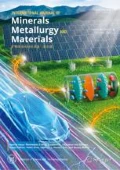Abstract
To ensure the quality of heavy plate products as determined by ultrasonic inspection, it is necessary to effectively control defects such as cracks and shrinkage cavities in heavy plates. Generally, some defects such as large size cracks exist due to insufficient deformation in the center of traditionally rolled plates. Compared with the traditional rolling process, gradient temperature rolling (GTR) process can effectively increase deformation inside heavy plates. In this study, the effect of GTR on crack healing was analyzed through a comparison experiment with the uniform temperature rolling (UTR). The results show that the GTR process could increase the plastic strain inside the heavy plate and effectively promote the healing process of the preset cracks. The degrees of crack healing at the center and quarter thickness position of the steel plate via GTR were greater than twice those of the plate via UTR. The GTR process can significantly reduce the internal defects of heavy plates and improve the defect detection level of heavy plate products. Also, The GTR process results in the formation of new crystal grains in the crack region, which is crucial to crack healing.
Similar content being viewed by others
References
H.L. Yu, X.H. Liu, X.W. Li, and A. Godbole, Crack healing in a low-carbon steel under hot plastic deformation, Metall. Mater. Trans. A, 45(2014), No. 2, p. 1001.
R.S. Xin, Q.X. Ma, and W.Q. Li, Microstructure and mechanical properties of internal crack healing in a low carbon steel, Mater. Sci. Eng. A, 662(2016), p. 65.
R.S. Xin, Q.X. Ma, D.D. Guo, and W.Q. Li, Restoration of impact properties of internal crack healing in a low carbon steel, Mater. Sci. Eng. A, 682(2017), p. 433.
R.S. Xin, J. Kang, Q.X. Ma, S. Ren, H.L. An, J.T Yao, J. Pan, and L. Sun, Evolution behaviors and mechanisms of internal crack healing in steels at elevated temperatures, Metall. Mater. Trans. A, 49(2018), No. 10, p. 4906.
X.X. Zhang, T. Lin, S.S. Zhu, S.L. Zhang, Z. Wang, and L. Ha, Effects of process conditions on crack healing in 30Cr2Ni4MoV steel during hot forging, Appl. Mech. Mater., 184–185(2012), p. 854.
D.B. Wei, J.T. Han, A.K. Tieu, and Z.Y. Jiang, Simulation of crack healing in BCC Fe, Scripta Mater., 51(2004), No. 6, p. 583.
D. Wei, J. Han, Z.Y. Jiang, C. Lu, and A.K. Tieu, A study on crack healing in 1045 steel, J. Mater. Process. Technol., 177(2006), No. 1–3, p. 233.
W. Deng, D.W. Zhao, X.M. Qin, L.X. Du, X.H. Gao, and G.D. Wang, Simulation of central crack closing behavior during ultra-heavy plate rolling, Comput. Mater. Sci., 47(2009), No. 2, p. 439.
X.K. Zhao, J.M. Zhang, S.W. Lei, and Y.N. Wang, Finite-element analysis of porosity closure by heavy reduction process combined with ultra-heavy plates rolling, Steel Res. Int., 85(2014), No. 11, p. 1533.
A. Li, X. Chen, C.S. Zhang, G.D. Cui, H. Zhao, and C. Yang, A novel crack healing in steels by gas nitrocarburizing, Appl. Surf. Sci., 442(2018), p. 437.
P. Cavaliere and A. Silvello, Crack repair in aerospace aluminum alloy panels by cold spray, J. Therm. Spray Technol., 26(2017), No. 4, p. 661.
C. Gunter, M.P. Miles, F.C. Liu, and T.W. Nelson, Solid state crack repair by friction stir processing in 304L stainless steel, J. Mater. Sci. Technol., 34(2018), No. 1, p. 140.
Y. Nie, C.J. Shang, X. Song, Y. You, C. Li, and X.L. He, Properties and homogeneity of 550-MPa grade TMCP steel for ship hull, Int. J. Miner. Metall. Mater., 17(2010), No. 2, p. 179.
Z.Q. Cao, Y.P. Bao, Z.H. Xia, D. Luo, A.M. Guo, and K.M. Wu, Toughening mechanisms of a high-strength acicular ferrite steel heavy plate, Int. J. Miner. Metall. Mater., 17(2010), No. 5, p. 567.
W. Yu, G.S. Li, and Q.W. Cai, Effect of a novel gradient temperature rolling process on deformation, microstructure and mechanical properties of ultra-heavy plate, J. Mater. Process. Technol., 217(2015), p. 317.
B.S. Xie, Q.W. Cai, Y. Yun, G.S. Li, and Z. Ning, Development of high strength ultra-heavy plate processed with gradient temperature rolling, intercritical quenching and tempering, Mater. Sci. Eng. A, 680(2017), p. 454.
G.S. Li, W. Yu, Q.W. Cai, and Z.Y. He, Effect of gradient temperature rolling (GTR) and cooling on microstructure and properties of E40-grade heavy plate, Arch. Civ. Mech. Eng., 17(2017), No. 1, p. 121.
X. Chen, Q.W. Cai, B.S. Xie, Y. Yun, and Z.Y. Zhou, Simulation of microstructure evolution in ultra-heavy plates rolling process based on Abaqus secondary development, Steel Res. Int., 89(2018), No. 12, p. 1800409.
G.S. Li, W. Yu, and Q.W. Cai, Investigation of the evolution of central defects in ultra-heavy plate rolled using gradient temperature process, Metall. Mater. Trans. B, 46(2015), No. 2, p. 831.
L.Y. Huang, K.S. Wang, W. Wang, K. Zhao, J. Yuan, K. Qiao, B. Zhang, and J. Cai, Mechanical and corrosion properties of low-carbon steel prepared by friction stir processing, Int. J. Miner. Metall. Mater., 26(2019), No. 2, p. 202.
E.L. David and H. Kazuhiro, Physical Metallurgy, 5th Ed., Elsevier, Amsterdam, 2014.
J.W. Cahn, Nucleation on dislocations, Acta Metall., 5(1957), No. 3, p. 169.
Author information
Authors and Affiliations
Corresponding author
Rights and permissions
About this article
Cite this article
Gao, Zh., Yu, W., Chen, X. et al. Effect of gradient temperature rolling process on promoting crack healing in Q500 heavy plates. Int J Miner Metall Mater 27, 354–361 (2020). https://doi.org/10.1007/s12613-019-1855-0
Received:
Revised:
Accepted:
Published:
Issue Date:
DOI: https://doi.org/10.1007/s12613-019-1855-0




